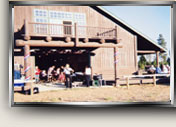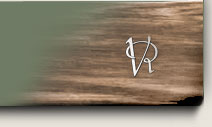Lake Maintenance
This page addresses the practices used to maintain Rainbow Lake (also known as "the pond") prior to its expansion in 2008 to about 3.2 acres and about 20 feet deep.
For information on expanding the lake see the Owners Only section
(password required).
Description
Rainbow Lake is (i.e. was until 2008) a long 2.1 acre
body of water that abuts Lots 3 thru 7 and surrounds two islands.
Maximum depth is 8.5 feet and much of the pond is much more shallow.
The pond is fed by groundwater seepage and is topped up
approximately three feet above the water table from the well near
the schoolhouse. The elevation of the water surface is 4,165
feet above sea level. There is no outlet except seepage
through the ground.
The lake is stocked with rainbow
trout in May and some trout survive over the winter.
Water Intake
A pipe from the well house near
the school runs down the pedestrian right-of-way between Lots 2
and 3 and delivers water at three valve-controlled points along the
west side of the pond. The pump is 15 horsepower and rated at
300 gallons per minute (though the pipe limits the flow to less than
300 gpm). The pressure at the wellhead is 450-500 psi. We
believe the pipe from the well is steel because PVC is not rated to
handle pressure this high.
The well pump runs on a timer for
about four hours a day. The ranch foreman runs the pump for
extra hours when the lake gets low and may shut it off during the
spring snow melt when the water table is almost at the surface of
the ground.
Chemistry
Tested in September of 2007, the
pond chemistry is good for trout. While the pH is higher than
ideal (8.19 parts per million found versus 6.5 to 7.5 desired) the
alkalinity of the water (78 ppm), which measures the "intensity" of
the pH indicates that the pH is not a problem. Phosphorous,
which contributes to the growth of algae and weeds, is at 0.127 ppm
- relatively low for a residential environment. The water is
chemically safe to drink but was not tested for bacteria that could
make it unsafe to drink. See the report on pond chemistry in
the Owners Only section of the web site.
Algae and Weeds
Weeds and algae sometimes make the pond less
attractive and interfere with fly fishing by snarling lines. In 2007 the ranch
had Aquacide evaluate samples of the weeds and algae in the pond.
They identified three types of weed as follows:
1. Milfoil looks like groves of trees
underwater. It has many leaves/branches off each main stem but the
main stem doesn’t branch into multiple stems.
2. Sago Pondweed is the long stringy weed with
long narrow leaves.
3. Duckweed is the small floating leaf that
looks like a four-leaf clover.
Aquacide also identified the two types of algae:
Filamentous Algae and Chara.
The algae and duckweed grow quickly and are
most detrimental to the appearance of the pond. The milfoil
and sago pondweed grow more slowly and snag fishing lines and hooks
in addition to being unsightly.
Algae and Weed Treatment
The ranch uses its rowboat and a tank with a
battery-driven pump to spray the pond for algae and weeds (see
photos below). The ranch chooses to treat them
separately because the algae is close to the shore and the weeds are
more evenly distributed. The ranch chooses to kill only some
of the weeds in order to provide habitat for the aquatic animals
that fish eat and to avoid a sudden massive decomposition of dead
weeds that would rob the water of oxygen the fish need for
respiration.
Treatment requires one person to row the boat
and one to manage the sprayer. Treatment must be done on calm
days because wind disperses the spray and can make the boat hard to
control.
For algae the ranch uses four gallons of
Cutrine-Plus liquid approximately four times per year for a total
material cost of about $700. The ranch plans to experiment
with a product called called Cide-Kick II that should make the
Cutrine-Plus go further and be more effective.
For weeds the ranch uses diquat dibromide
(brand name Reward, also sold as Weedtrine-D) about two or three
times per year for a total material cost of about $400.
Removing all the weeds would increase the cost.
The ranch foreman rakes out the weeds and algae
after killing them so their decomposition doesn't rob the water of
oxygen and so that the dead plant material does not provide
nutrients for more algae and weeds to grow.
Possibly More Effective Treatment
The ranch
received a
proposal from Aquatechnex, who manages the golf course ponds at
Crosswater, to treat the current pond for about $7,000 per year.
They could kill everything and make the pond as clear as a swimming
pool if that is what we want. The biggest change from current
treatment would be to apply a product called Sonar in April or May,
just as the weeds start to grow. Over a period of a month
Sonar will kill every plant that grows in the water, including the
reeds and cattails. Aquatechnex would also treat periodically
with Cutrine-Plus and diquat. The ranch could continue with
Aquatechnex every year or could take over treatment itself.
The Sonar for
one treatment would cost $1,400 to $2,100 if the ranch applied the
product itself.
Lake Maintenance Photos
|
|

|
|
Milfoil
Very common. Grows from bottom and forms tangled mat at surface. Late season seed heads may extend above the surface. Best to treat shortly after starts growing in spring. |
|

|
|
Sago Pondweed
Stems branch with leaves alternately attached. Nutlets appear like beads on a string. |
|

|
|
Chara with Filamentous Algae
Chara looks like a weed and is attached, but not rooted, to the bottom. In this photo it is enmeshed in filamentous algae which looks like moss or scum. Filamentous algae begins growth at the bottom and rises as a bubble-filled mass. |
|

|
|
Mixed Weeds and Algae
The darker green below the surface on the right side of the photo is milfoil. The floating string toward the upper left is sago pondweed. The very bright green dots floating on the surface, both individually and in mats, is duckweed, which floats free and is not attached to the bottom. The medium green on the surface is filamentous algae. |
|

|
|
Rowboat with Tank and Sprayer
The sprayer is lying along the back seat. The electric pump is on top of the tank and the battery for it is out of sight in the bottom of the boat. |
|
|
|

|
|
Pouring Algaecide into Tank
Cutrine-Plus is mixed with water in the tank before spraying. |
|

|
|
Raking Treated Weeds
The pole that the boat is pulling has long nails set into the bottom of it to rake up the weeds. |
|

|
|
Raking Pond Weeds
The rake gathers sago pondweed, milfoil, and whatever duckweed and algae are caught up in the larger weeds. |
|
|
Return to Ranch Operations






